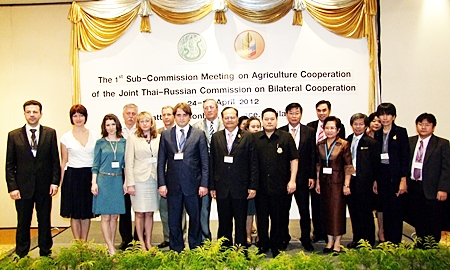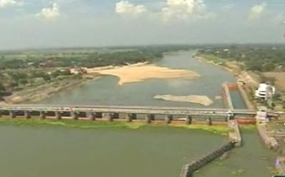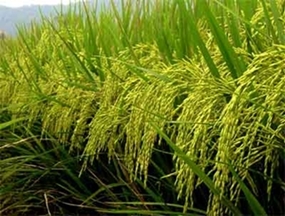|
Thailand, Russia discuss joint agricultural projects in Pattaya

Thai and Russian agricultural
officials met at the Dusit Thani Pattaya where they agreed to draft
bilateral food-safety standards and committed to joint research.
Thai and Russian agricultural officials agreed to draft
bilateral food-safety standards and committed to joint research at a meeting
in Pattaya.
Minister of Agriculture and Cooperatives Theera Wongsamut
led the Thai delegation to the April 25 session at the Dusit Thani Hotel,
with the Russians represented by Deputy Agriculture Minister Llya V.
Shestakov.
The meeting was the first since the two nations signed
their latest agricultural cooperation agreement last year and primarily
served to set the scope for the first joint projects. Committee members
considered reports and suggestions related to regulations for joint
agricultural cooperatives.
The major achievement at the session, however, was an
agreement to jointly work on food safety, including sanitary and
phytosanitary measures. The two sides also agreed to promote joint
scientific and agricultural research.
As part of the food-safety initiative, Thailand’s
Department of Fisheries and Russia’s Federal Service for Veterinary and
Phytosanitary Surveillance will cooperate to control quality and safety of
imported and exported plants and plant products. Contacts for each side will
be named and help provide information on regulations.
As for research, Thailand presented 14 projects,
including studies on coastal agriculture, water resources management,
irrigation technology, pest control and soil microorganisms. (CPRD)
|

|
PM rejects consumer
goods price hike claim
Prime Minister Yingluck Shinawatra on Thursday rejected
claims that consumer prices are skyrocketing, saying the information
gathered by government officials indicated that prices are on a downward
trend.
However, she said the Commerce Ministry has been assigned
to set up a public complaints center and to seek measures to ease the impact
of the cost of living.
The premier said she is confident that prices will return
to normal in the second half of this year.
Ms Yingluck argued that the public might have felt that
consumer product prices were increasing overall as a result of psychological
effects despite the fact that the prices are going down.
The feeling might have stemmed from last year’s massive
flood that spurred a price rise and even though prices have fallen, the
public is not satisfied with the trend, she said.
Citing a government-sponsored survey, the premier
insisted prices were gradually improving. She also pledged that her
government would prepare measures to reduce the burden of certain groups of
people particularly low-income earners and small- and medium enterprise
(SME) operators.
Various measures implemented by the government were meant
initially to ease the impact on the cost of living including the start-up
salary rise and daily minimum wage hike, she said.
Some consumer products were not fully 100 percent back to
normal as some factories in flooded industrial estates have just resumed
operations, the premier said. It was expected that the factories could
resume normal operation by the second half of the year.
Ms Yingluck asked entrepreneurs to ensure fair price for
consumers while the commerce ministry will closely monitor prices to protect
consumers. (MCOT)
|

|
Drought threatens Eastern Seaboard industrial estates
In an attempt to avert a repetition of the 2005 drought
crisis, the Industrial Estate Authority of Thailand (IEAT) is closely
monitoring the drought in the East, coordinating with concerned agencies to
ensure adequate water supply for the eastern industrial estates, IEAT
Governor Veerapong Chaiperm said on Friday.

The governor said the water level in three reservoirs in
the east dropped to 50 percent of their capacity in April this year, similar
level to that in April 2004 prior to the 2005 drought crisis when the water
level fell to only 15 percent of the reservoirs’ capacity.
The industrial estate authority is coordinating with the
Royal Irrigation Department and Eastern Water Resources Development and
Management (EASTW), suppliers of raw water for the industrial sector, to
handle the situation to ensure enough water supply to five eastern
industrial estates - Maptaput, Padaeng, Hemaraj Eastern, Asia and RIL in the
eastern province of Rayong.
IEAT plans to seek funds from the Ministry of Industry to
build more reservoirs under a three-year project being studied, he said.
Five industrial estates use about 230,000 cubic meters
per day. Operators need production plans to suit the water situation and
water recycling and water production from sea water are being considered.
Veerapong said after the rainy season ends, the water
level in reservoirs will be assessed whether more rain-making operations are
needed in the area.
Meanwhile, Industry Minister Pongsawat Svasti said the
water level measured on April 20 was higher than during the 2004-2005 water
crisis and more water flowed into a reservoir, so raw water is adequate for
production in industrial estates.
In another attempt to fight drought, the Ministry of
Agriculture and Cooperatives has been speeding up making artificial rain.
Supatra Thanaseniwat, Permanent Secretary for Agriculture
said the rainmaking operation started Feb 20 and since then to April 30, the
Bureau of Royal Rainmaking and Agricultural Aviation has run 1,341 flights,
making rain in 56 provinces with the highest daily rainfall recorded at
141.5 millimeters.
In April alone, 781 flights made artificial rain in 55
provinces.
The artificial rainmaking operation continues to increase
the amount of water in reservoirs in this year’s dry season.
Regarding the amount of water in the country’s
reservoirs, Kitti Tancharoen, assistant governor for Hydro Power Plants of
the Electricity Generating Authority of Thailand (EGAT) said as of May 2,
EGAT reservoirs contain 59 percent of their capacity or 36 million cubic
meters, six percent higher than the amount of water recorded on the same
period last year.
Water in the reservoirs would be enough for agriculture
if there is no further rainfall before the beginning of the rainy season.
He said a subcommittee, following up and analyzing the
water situation in the Chao Phraya Basin agreed to release more water from
the Bhumibol and Sirikit Dams to suit actual water use and to supply water
to farmlands in the Chao Phraya project from April 29 to May 6. (MCOT)
|

|
FAO: World rice harvest
forecast to rise in 2012
The world rice harvest for 2012 is expected to surpass
the strong showing of 2011 as the erratic climate conditions caused by the
La Nina weather phenomenon dissipate and farmers increase their plantings,
according to an initial forecast by the United Nations Food and Agriculture
Organization (FAO) in its Rice Market Monitor released on Friday.

FAO is predicting world paddy production of 732.3 million
tonnes (488.2 million tonnes on a milled basis) for 2012, a 1.7 percent or
12.3 million tonne increase over its estimate for total production in 2011.
Last year’s total was also revised slightly downward in the Rice Market
Monitor.
Asia, where rice is the staple food, will be chiefly
responsible for the advances in production. Large absolute gains in output
are forecast for Bangladesh, China, India, Myanmar, Pakistan, the
Philippines and, especially, Thailand, which is recovering from last year’s
disastrous floods. The outlook is also positive in Indonesia, Malaysia and
Sri Lanka, which have already harvested their main 2012 crops.
An increase in plantings by farmers will drive higher
output, although more neutral climatic conditions associated with the end of
La Nina will be required to support more bountiful harvests. Worldwide,
farmers are expected to increase areas for planting by 1.6 percent to a
total of 165.1 million hectares.
Beyond Asia, harvests should rebound in Africa (led by
Mali, Senegal and Nigeria), but fall in the European Union, the United
States, Latin America and the Caribbean.
Strong output in Asia, however, also means that the
region that consumes the most rice will require fewer imports, and FAO is
forecasting that the global rice trade in 2012 will fall by 900,000 tonnes
to 34.3 million tonnes, a decline of 2 percent over the record set in 2011.
The decline takes into account an upward revision of 1.5 million tonnes over
its initial prediction in January.
Imports are expected to rise, however, in China, Africa,
the European Union, North America and Latin America.
Robust production coupled with weaker demand has created
downward pressure on international prices, especially after India lifted its
ban on regular rice exports.
With prices of competitors far lower, Thailand is
expected to see its sales falling sharply, even though the country is still
forecast to retain its position as the leading rice exporter.
Countries such as Australia, Cambodia, India, Pakistan
and Viet Nam should capture larger shares of the market as they offer more
affordable rice prices.
FAO revised its estimate of world paddy output in 2011
downward by 1.4 million tonnes to a total of 720 million tonnes (480.1
million tonnes of milled rice). Nonetheless, the new figures still represent
a 2.5 percent, or 17.7 million tonne, increase over world output for 2010.
(FAO)
|

|
|

